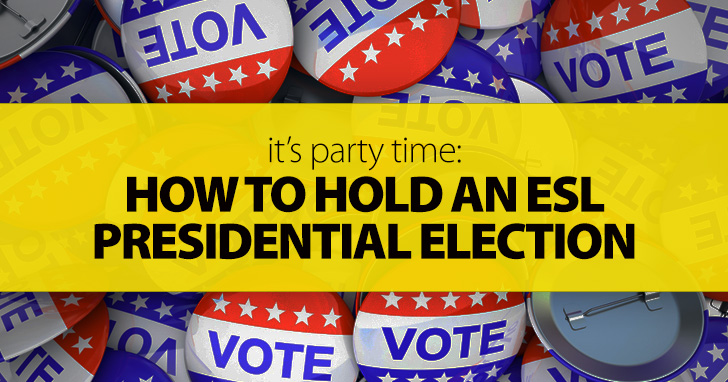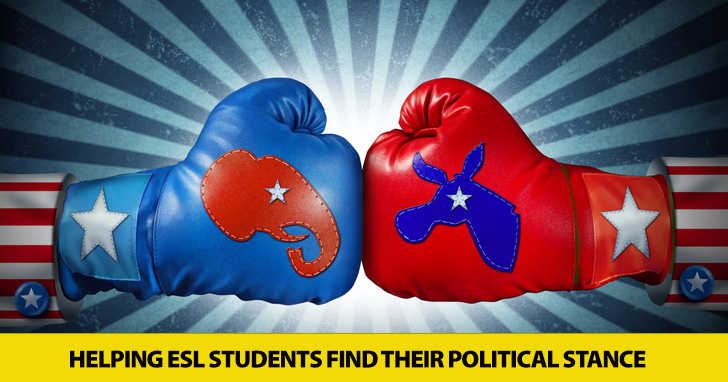Party Time: How to Hold an ESL Presidential Election


Some come from cultures which frown on the public discussion of politics, and might even get in trouble for expressing anything but traditional opinions. ESL classrooms, then, can be a place for our students to engage with political issues without fear of judgment or punishment, and can become a forum for open discussion and learning from peers. Your school may not permit this kind of discussion, perhaps fearful of being accused of ‘pushing’ a particular agenda; this need not be the case, and such classes can be positive moments of discovery and open-mindedness which add meaningfully to your students’ experience of living abroad and speaking a foreign language.
Here are some tips for getting the ball rolling and helping your students to understand their positions on different political topics:

We’re not trying to ruffle feathers here, so think carefully about the background and demographics of your students. The best classes for this type of discussion are mixed-nationality, mixed-gender, and preferably with some variety in age. The least successful have been homogeneous groups of students - those all from the same country, for example. The real benefits come when there are multiple points of view - as many as possible - so that students can experience that special moment that comes with the realization, “Wow, I didn’t know anyone thought like that”.
Depending on how long your group has worked together, you may wish to give them a short talk on the importance of tolerance and empathy. Remind them that everyone is different, but their opinions are equally valid, and that whatever they may have been told back home or since, there is always more than one way to look at something, and always a viewpoint they have yet to hear.
‘Left’ and ‘Right’ may make sense to students who are familiar with multi-party democracy, but not to others. Single out a handful of issues and then, using the board, very basically break down left- and right-wing views in those terms, e.g.
| Issue | Left | Right |
| Taxation | High for the rich, low for others | Low for everyone |
| Regulation | As much as needed | As little as possible |
| Crime | Rehabilitation | Punishment |
| Defense | Passive / humanitarian | Active / pre-emptive |
| Healthcare | Public | Private |
| Immigration | Moderate | Strict |
Obviously this is almost laughably simplistic, but it’s a place to start with students for whom the concept of left- and right-wing thinking is unfamiliar.
Try to find governments around the world which exemplify one or more of these policies. For example:
| Strict immigration policy / right-wing: | Italy, Australia, Denmark |
| Harsh punishments for criminals / right wing: | China, Saudi Arabia |
| Free, high-quality public healthcare / left-wing: | France, UK, Denmark |
| High taxes on the rich/ left-wing: | Sweden, Belgium, Canada |
It might help at this stage for the students to figure out what kind of government they have, based on the simple guidelines you’ve placed on the board. Some countries are enigmas in this regard; China has a low-regulation, right-wing economic model, governed by an apparently archetypal left-wing, Communist government, wrapped up in a right-wing police state but with traditionally left-wing models of land ownership and the provision of public services. I lived there for four years, but I could have stayed for ever and still failed to wrap my head around it.
Your students could write these, or (preferably) you could hand out sheets which the students will use to interview each other. Encourage them to take detailed notes - this ensures that all four skills are practiced - and model how they might report what they heard, e.g. “Ahmed told me that he doesn’t support the death penalty, but he thinks murderers should stay in prison for life. He wants people to work hard and make their own way, so he doesn’t support a big welfare state, but he thinks sick people should get government help if they’ve paid their taxes.”
Here are some possible statements for the interview, designed to elicit not only a closed (yes/no) response but some detail too:
Especially with more mature, multi-national groups, sets of questions like these have kicked off truly remarkable debates. Sit a Kuwaiti and a Danish student together for something like this, and just see what happens; you could almost make a reality TV show out of it. Debate is inevitable throughout the interview process, but I prefer to hold the main discussion once we’ve completed the interview, and given each student the chance to place his partner somewhere on the political spectrum.
The results will surprise you; that’s perhaps the only certainty. I’ve had Saudi students who turned out to be in favor of gay marriage, against the death penalty, and big fans of universal suffrage. And I’ve had European students who want their borders closed, their tax systems abolished, and the introduction of compulsory military service. It’s fascinating; I learn as much as my students do.
You could ask the students to write up their partners’ viewpoints as a blog entry, or research the political parties of other parts of the world. You could assign important leaders or political philosophies for research and presentation tasks. Op-ed articles, diary entries, fake news reports… All are possible. I encourage you to engage your students on these topics, provided their level is high enough and you won’t get into trouble with your school! It’s a thoroughly interesting exercise, produces lots of great language, and might just open some young minds to new possibilities.